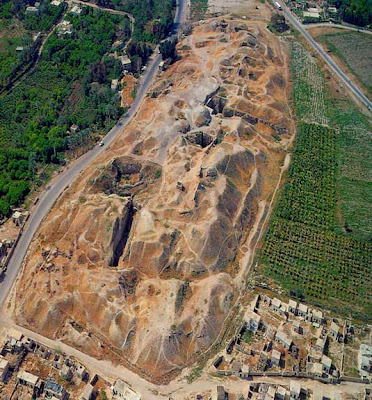From msnbc.msn.com today: Egypt said Tuesday that its archaeologists have unearthed a Ptolemaic-era temple dating back more than 2,000 years, that may have been dedicated to the ancient cat goddess, Bastet.
The Supreme Council of Antiquities said the temple's ruins were discovered in the heart of the Mediterranean port city of Alexandria, the seat of the dynasty founded by Alexander The Great in the 4th century B.C., that ended with the suicide of Cleopatra 300 years later. The statement said the temple was thought to belong to Queen Berenice, wife of King Ptolemy III who ruled Egypt in the 3rd century B.C.”
Bastet statue. From msn.com/
And from Lewis Mumford, we read that “The earliest ruins recognizable as cities usually disclose only the original dominants, the temple and the palace, sometimes the granary, within the walled citadel or sacred precinct. This was the activating nucleus in the urban implosion. The only complete early “cities” of permanent materials are the “ cities of the dead”, such as that at Saqqarah built around the step pyramid tomb of Zoser (upper), c. 2700-2650. Since the Egyptians took pains in their tombs to reproduce in miniature all the necessary facilities for daily life, there is good reason, many Egyptian scholars believe, to suppose that this mortuary “city” reproduced with equal faithfulness the layout and buildings of its secular counterpart”….
Pyramid of Zoser. From members.virtualtourist.com/m/6afa9/1e9417/
Mumford also states that “the ceremonious burial of the dead in graves marked by a cairn, a tree or a tall rock, formed perhaps the first permanent meeting place for the living: the home of the ancestral spirits, the shrine of a god, the embryon of a city. Like the grave, the cave is a womb to which primitive man returns for security and secrecy….” According to him, Egypt and Mesopotamia bring out significant alternatives to urban evolution, beginning in a few river valleys: the Nile, the Tigris-Euphrates, the Indus and the Hwang Ho. And they are based on: ceremonial meetings and temples. This transformation of small villages into cities was not a mere change of size and scale: it was a change of direction and purpose manifested in a new type of organization were rivers were the first highroads, once boats were invented.
REFERENCESMumford, Lewis. The City in History. 1979. New York.
http://www.msnbc.msn.com/id/34935739/ns/technology_and_science-science/
READ MORE
"Las ruinas de ciudades, palacios y barcos de la era faraónica y grecorromana yacen conservados en los alrededores de Alejandría, uno de los lugares de excavación más ricos del Mediterráneo.
Los restos del templo, de 60 metros de altura y 15 de ancho, son la primera muestra de la ubicación del barrio real de Alejandría, dijo Mohamed Abdel Maqsud, que dirigió la excavación arqueológica. ..."
http://www.lanacion.com.ar/nota.asp?nota_id=1223873&origen=NLCien


No comments:
Post a Comment